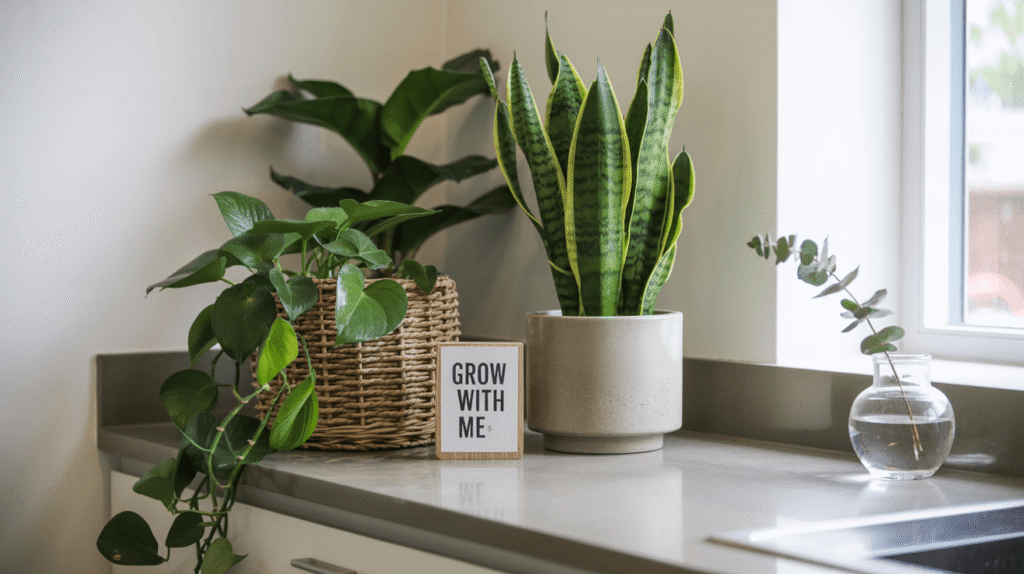The kitchen is the heart of every home—it’s where we cook, gather, and start or end our day. But beyond the delicious aromas and culinary experiments, the kitchen can also become a sanctuary of greenery. Adding indoor plants for the kitchen not only makes the space more beautiful but also improves air quality, reduces stress, and provides a touch of nature where you need it most.
From herbs that double as ingredients to air-purifying houseplants that thrive in warm, humid conditions, the kitchen is a surprisingly perfect place for greenery. Whether your kitchen is large and bright or cozy and compact, there are indoor plants to fit every style, need, and skill level.
In this guide, we’ll explore the best indoor kitchen plants, their benefits, styling tips, and care strategies to transform your cooking space into a fresh, vibrant, and functional oasis.
Benefits of Having Indoor Plants in the Kitchen
Before we dive into plant suggestions, let’s look at why kitchens make a great home for plants.
1. Air Purification
Cooking produces odors, smoke, and sometimes lingering smells. Plants like snake plants, spider plants, and peace lilies filter indoor air naturally.
2. Stress Reduction
Greenery has been proven to reduce stress levels and boost creativity—perfect for experimenting with new recipes.
3. Practical Use in Cooking
Herbs like basil, rosemary, thyme, and mint are both decorative and functional, giving you fresh ingredients at your fingertips.
4. Natural Décor
Indoor plants add warmth and life, making kitchens more inviting without taking up much space.
5. Humidity Balance
Kitchens often get steamy. Plants that love moisture (like ferns and pothos) thrive in this environment.
Best Indoor Plants for Kitchens
Choosing the right kitchen plants depends on lighting, space, and care routine. Here are the top recommendations:
🌿 Herbs for the Kitchen (Practical + Beautiful)
1. Basil
- Loves sunlight and warmth.
- Perfect for windowsills with bright light.
- Use fresh leaves for pasta, salads, and sauces.
2. Mint
- Easy to grow indoors.
- Adds freshness to drinks, desserts, and teas.
- Thrives in indirect light with regular watering.
3. Rosemary
- Hardy herb with a fragrant aroma.
- Great for roasted dishes and marinades.
- Prefers direct light near a sunny window.
4. Thyme
- Compact and easy to grow in small pots.
- Adds flavor to soups, stews, and meats.
- Needs plenty of sun and minimal water.
5. Chives
- Adds mild onion flavor to dishes.
- Thrives in pots with good drainage.
- Grows well with moderate sunlight.
🌱 Air-Purifying Plants for Kitchens
6. Snake Plant (Sansevieria)
- Extremely hardy and low maintenance.
- Filters toxins from the air.
- Perfect for low-light kitchen corners.
7. Spider Plant (Chlorophytum comosum)
- Excellent air purifier.
- Easy to grow, even for beginners.
- Looks great in hanging baskets.
8. Peace Lily (Spathiphyllum)
- Elegant white flowers brighten kitchens.
- Absorbs harmful toxins like benzene and carbon monoxide.
- Thrives in indirect light.
9. Pothos (Devil’s Ivy)
- Great trailing plant for shelves or hanging pots.
- Low-maintenance and fast-growing.
- Handles low light and varying humidity.
10. Aloe Vera
- Needs bright light.
- Leaves contain soothing gel for burns—perfect for accidental kitchen burns.
- Hardy and drought-tolerant.
🌸 Decorative Kitchen Plants
11. Succulents
- Small, low-maintenance, and stylish.
- Great for sunny window sills or countertops.
- Many shapes and colors available.
12. Orchids
- Elegant and perfect for bright kitchens.
- Long-lasting blooms add sophistication.
- Loves humidity from cooking.
13. Ferns
- Thrive in humid kitchen environments.
- Add lush greenery to shelves or hanging baskets.
- Need consistent moisture.
14. ZZ Plant
- Tolerates neglect, low light, and infrequent watering.
- Adds glossy, deep green foliage.
- Great for modern or minimalist kitchens.
15. Philodendron
- Adaptable to low and bright light.
- Trailing vines look stunning on top of cabinets.
- Loves humidity but tolerates less water.
How to Choose the Right Kitchen Plant
Not all kitchens are alike. Consider these factors before picking your green companion:
1. Light Availability
- Bright kitchens: Herbs, Aloe Vera, Orchids.
- Low-light kitchens: Snake Plant, ZZ Plant, Pothos.
2. Space Constraints
- Small kitchens: Succulents, hanging plants, mini herbs.
- Large kitchens: Ferns, Peace Lilies, trailing philodendrons.
3. Maintenance Level
- Low-maintenance: Snake Plant, ZZ Plant, Pothos.
- Higher care: Orchids, ferns, and basil.
Creative Ways to Style Plants in Your Kitchen
Adding plants to your kitchen doesn’t mean cluttering countertops. Try these ideas:
- Hanging Baskets → Perfect for pothos, spider plants, and trailing ivy.
- Windowsill Gardens → Herbs like basil and rosemary thrive here.
- Floating Shelves → Display small succulents or ferns.
- Above Cabinets → Great spot for trailing philodendrons or pothos.
- Mason Jar Herb Garden → A stylish DIY project for small kitchens.
- Corner Floor Planters → Add height with a peace lily or snake plant.
Step-by-Step Guide: Caring for Kitchen Plants
1. Watering
- Herbs: Frequent watering but ensure drainage.
- Succulents: Once every 2–3 weeks.
- Tropical plants: Keep soil moist but not soggy.
2. Lighting
- Rotate plants every few weeks for even growth.
- Add grow lights if your kitchen lacks windows.
3. Humidity & Airflow
- Kitchens are naturally humid—great for orchids and ferns.
- Ensure good airflow to prevent mold.
4. Fertilizing
- Herbs: Every 2 weeks during growing season.
- Houseplants: Monthly with diluted fertilizer.
5. Pruning & Cleaning
- Trim herbs regularly to encourage growth.
- Wipe leaves of houseplants to remove grease buildup from cooking.
Common Mistakes to Avoid
- Overwatering: Especially dangerous for succulents and snake plants.
- Placing plants too close to stoves: Heat can damage leaves.
- Ignoring light needs: Even hardy plants need some indirect light.
- Crowding plants: Leave room for airflow.
Frequently Asked Questions (FAQ)
1. What plants grow best in kitchens?
Herbs like basil, mint, and rosemary are perfect for kitchens. Air-purifying plants like snake plants, spider plants, and pothos also do well.
2. Can you grow herbs indoors all year?
Yes! With enough light (natural or grow lights), herbs can thrive indoors year-round.
3. Which plants are safe for kitchens with low light?
ZZ plants, pothos, peace lilies, and snake plants are excellent low-light options.
4. Do kitchen plants need special pots?
Not necessarily, but ensure they have drainage holes to prevent root rot.
5. How do I prevent grease from harming plants?
Wipe leaves regularly with a damp cloth to remove kitchen grease and dust.
Conclusion: Bring Life Into Your Kitchen
The kitchen is more than just a cooking space—it’s a place of energy, creativity, and comfort. By adding indoor plants for kitchens, you can enjoy fresher air, better moods, and even fresher ingredients right at your fingertips.
Whether you start with a windowsill herb garden or add a low-maintenance snake plant, the results will instantly brighten your space.
🌿 Ready to explore more plant-friendly guides? Visit Green Plant Zone today for care tips, styling ideas, and plant recommendations for every corner of your home.

Hi, I’m the creator of Green Plant Zone, a space dedicated to plant lovers. I share tips on indoor and outdoor gardening, plant care guides, and eco-friendly living. My mission is to help you grow healthier, happier plants and bring more greenery into everyday life.
